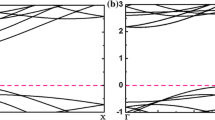Abstract
Structural, electronic, and electrical responses of the H-capped (6,0) zigzag single-walled silicon carbide nanotube (SiCNT) was studied under the parallel and transverse electric fields with strengths 0–140 × 10−4 a.u. by using density functional calculations. Analysis of the structural parameters indicates that resistance of the nanotube against the applied parallel electric field is more than resistance of the nanotube against the applied transverse electric field. The dipole moments, atomic charge variations, and total energy of the (6,0) zigzag SiCNT show increases with any increase in the applied external electric field strengths. The length, tip diameters, electronic spatial extent, and molecular volume of the nanotube do not change significantly with any increasing in the electric field strength. The energy gap of the nanotube increases with any increases in the electric field strength and its reactivity is decreased. Increase of the ionization potential, electron affinity, chemical potential, and HOMO and LOMO in the nanotube with increase of the applied external electric field strengths indicates that the properties of SiCNTs can be controlled by the proper external electric field for use in nano-electronic circuits.





Similar content being viewed by others
References
S. Ijima (1991). Nature 354, 56–58.
V. Derycke, R. Martel, J. Appenzeller, and Ph Avouris (2002). Appl. Phys. Lett. 80, 2773–2775.
C. Liu, Y. Y. Fan, M. Liu, H. T. Cong, H. M. Cheng, and M. S. Dresselhaus (1999). Science 286, 1127–1129.
B. Zurek and J. Autschbach (2004). J. Am. Chem. Soc. 126, 13079.
A. Nojeh, G. W. Lakatos, S. Peng, K. Cho, and R. F. W. Pease (2003). Nano Lett. 3, 1187–1190.
V. Linssa, T. Halma, W. Hoyera, F. Richtera, and N. Schellb (2003). Vacuum 70, 1–9.
X.-H. Sun, C.-P. Li, W.-K. Wong, N.-B. Wong, C.-S. Lee, S.-T. Lee, and B.-T. Teo (2002). J. Am. Chem. Soc. 124, 14464.
K. M. Alam and A. K. Ray (2009). J Nanopart .Res. 11, 1405–1420.
A. Wu, Q. Song, L. Yang, and Q. Hao (2011). Comput. Theor. Chem. 977, 92–96.
K. M. Alam and A. K. Ray (2007). Nanotechnology 18, 495706.
M. Zhao, Y. Xia, R. Q. Zhang, and S. T. Lee (2005). J .Chem. Phys. 122, 214707.
Y. Miyamoto and B. D. Yu (2002). Appl. Phys. Lett. 80, 586–588.
K. H. Khoo, M. S. C. Mazzoni, and S. G. Louie (2004). Phys. Rev. B 69, 201401(R).
G. Y. Guo, S. Ishibashi, T. Tamura, and K. Terakura (2007). Phys. Rev. B 75, 245403.
C. Attaccalite, L. Wirtz, A. Marini, and A. Rubio (2007). Phys. Status Solid. B 244, 4288–4292.
M. T. Baei, A. Ahmadi Peyghan, and M. Moghimi (2012). J .Mol. Model. 18, 4477–4489.
P. K. Chattaraj, U. Sarkar, and D. R. Roy (2006). Chem. Rev. 106, 2065–2091.
K. K. Hazarika, N. C. Baruah, and R. C. Deka (2009). Struct. Chem. 20, 1079.
R. G. Parr, L. Szentpaly, and S. Liu (1999). J. Am. Chem. Soc. 121, 1922–1924.
H. Sabzyan and D. Farmanzadeh (2007). J. Comput. Chem. 28, 923–931.
M. Schmidt, et al. (1993). J. Comput. Chem. 14, 1347–1363.
P. Politzer, P. Lane, J. S. Murray, and M. C. Concha (2005). J. Mol. Model. 11(1), 1.
Z. Peralta-Inga, P. Lane, J. S. Murray, S. Boyd, M. E. Grice, C. J. O’Connor, and P. Politzer (2003). Nano Lett. 3(1), 21–28.
Author information
Authors and Affiliations
Corresponding author
Electronic supplementary material
Below is the link to the electronic supplementary material.
Rights and permissions
About this article
Cite this article
Peyghan, A.A., Baei, M.T., Hashemian, S. et al. First Principles Calculations of Electric Field Effect on the (6,0) Zigzag Single-Walled Silicon Carbide Nanotube for use in Nano-Electronic Circuits. J Clust Sci 24, 591–604 (2013). https://doi.org/10.1007/s10876-012-0524-5
Received:
Published:
Issue Date:
DOI: https://doi.org/10.1007/s10876-012-0524-5




